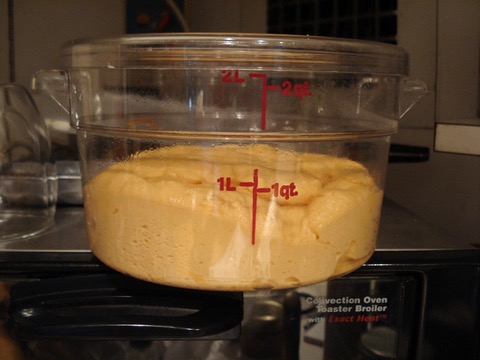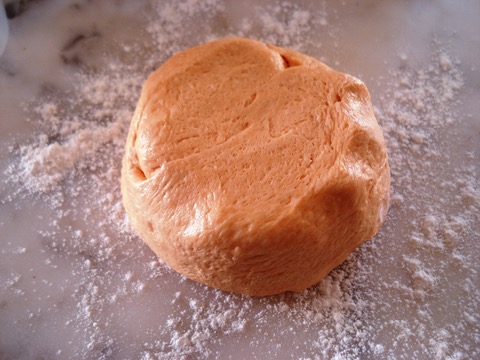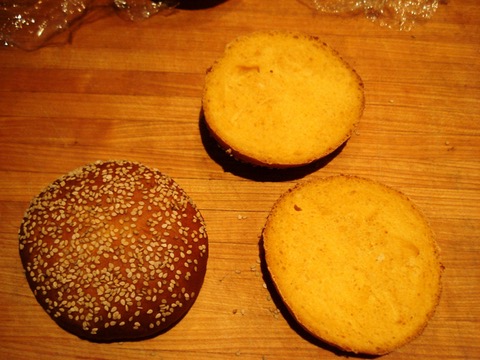Golden Burger Buns
/Makes: 4 Sweet Potato Hamburger Buns, 4 by 2 inches high
Oven Temperature: 400°F/200˚C
Baking Time: 15 to 20 minutes
Dough Starter (Sponge): Minimum 1 hour, Maximum 4 hours (or overnight refrigerated)
Minimum Rising Time: About 3 1/2 hours
When I wrote The Bread Bible, I didn’t include burger buns thinking no one would go to the effort of making them. Well I was wrong—I do! I’ve tried many versions, including the Sweet Heart of Wheat, Basic Hearth Bread, and even Ten Grain. They were all wonderful but what I really wanted was a softer bread so I switched to sweet potato dough. My first trials were with added old starter and though good, they kept the dough from being as soft as I had hoped for.
Here, just in time for the rest of the grilling season (which for me is all year!) are is my top favorite bun. The sweet potato adds a beautiful golden color, moistness and softness. I always toast them lightly—if the grill is on, I do it on the grill, but watching carefully as they toast within seconds.
These are great for lots more than burgers for example crab cakes, or even fried eggs, chicken, tuna, or egg salad.
Dough Starter (Sponge)
Early in the morning or the night before bake the potato and start the sponge
1) Bake the potato: In a 375°F. oven bake the potato 50 minutes or until tender. Cool, peel, and put it through a ricer or strainer or mash it. Measure or weigh out 1/2 cup (3.5 ounces)
2) Make the dough starter (sponge) In a large bowl (mixer bowl if using a stand mixer), place the flour, water, honey, and yeast. Whisk until very smooth to incorporate air, about 2 minutes. The dough will be the consistency of a thick batter. Scrape down the sides.
Flour Mixture



(For bread machine see note at end)
3) Combine the ingredients for the flour mixture In a medium bowl, whisk together the flour (reserve the 2 tablespoons if mixing by hand), dry milk, and yeast. Sprinkle this on top of the sponge and cover it tightly with plastic wrap. Allow it to ferment for 1 hour or up to 4 hours at room temperature. During this time the sponge will bubble through the flour blanket in places. This is fine.
4) Mix the dough Add the butter and mashed potato. With the dough hook mix on low speed (#2 Kitchen Aid) for 1 minute or until the flour is moistened to form a rough dough. Scrape down any bits of dough. Cover the top of the bowl with plastic wrap and allow the dough to rest for 20 minutes. Sprinkle on the salt. Knead the dough on medium speed (#4 Kitchen Aid) for 7 to 10 minutes. It will be smooth and shiny and slightly sticky to the touch. With an oiled spatula, scrape down any dough clinging to the sides of the bowl. If the dough is too sticky, scrape it onto a lightly floured counter and knead in a little more flour. If it is too stiff, spray it with a little cold water and knead it in. (It should weigh about 1 pound/ 454 to 460 grams.)
5) Let the dough rise Using an oiled spatula or dough scraper, scrape the dough into a 2 quart dough rising container or bowl, greased lightly with cooking spray or oil. Push down the dough and lightly spray or oil the top. Cover the container with a lid, or plastic wrap. With a piece of tape mark on the side of the container approximately where double the height would be. Allow the dough to rise (ideally at 75 to 80°F.), 1 1/2 to 2 hours until doubled.
Using an oiled spatula or dough scraper, remove the dough to a floured counter and gently press it down to form a rectangle. It will be full of air and resilient. Try to maintain as much of the air bubbles as possible. Pull out and fold the dough over from all 4 sides into a tight package or give it 2 business letter turns and set it back in the container. Again oil the surface, cover, mark where double the height will now be and allow it to rise for 1 1/2 to 2 hours or until it reaches the mark. (It will fill it fuller than before because it is puffier with air). [Or refrigerate overnight, pushing down once or twice during the first 2 hours and take out about 1 hour. before shaping.]
6) Shape the dough and let it rise Turn the dough onto a lightly floured counter and divide it into 4 equal pieces about 4 ounces / 112 to 116 grams each. Shape into balls and set several inches apart on parchment. (If you have a large peel you will be able to transfer them on the parchment by slipping it between the counter and the parchment. Alternatively, line a baking sheet with the parchment and baking the buns on the parchment-lined sheet.
Allow the buns to rest for 15 to 20 minutes. Flatten to 4 inches by 3/4 inch high. Spritz with water and sprinkle with sesame seeds, pressing them in with your fingers. Cover with a large plastic box or cover it lightly with plastic wrap that has been coated with non-stick cooking spray and allow it to rise until puffy--30 minutes to 1 hour (4 to 4 1/4 inches by 1 1/4 inches and when pressed gently with your finger tip the depression slowly fills in).
7) Preheat the oven
1 hour before baking preheat the oven to 400°F. Have the oven shelf at the lowest level and place an oven stone or baking sheet on it and a cast iron pan or sheet pan on the floor of the oven before preheating.
8) Bake the bread (turn half way through) Spritz the buns with water and quickly but gently set the pan on the hot baking stone or hot baking sheet. Toss 1/2 cup of ice cubes into the pan beneath. Immediately shut the door and bake 15 to 20 minutes or until medium golden brown and a skewer inserted in the middle comes out clean. (An instant read thermometer inserted into the center will read 190°-206°F/88°-96°C.) Half way through baking, rotate the pans half way around (after 10 minutes) for even baking.
9) Cool the bread
Remove the buns from the oven and set them on a wire rack. to cool top-side-up.
Notes:
If not using the dry milk you can replace the water with 1/2 cup plus 1 tablespoon of milk, preferable nonfat, scalded (brought to the boiling point) and cooled to lukewarm.
If you’d prefer to mix the dough in a bread machine, mix the sponge starter in a bowl and scrape it into the bread machine container. Sprinkle the flour mixture on top. Mix for 3 minutes, allow to rest for 20 minutes. Add the salt and mix for another 3 minutes. Then knead for 7 minutes.
The Rose Ratio
flour: 100% (Includes starch contained in the potato)
water: 64.1% (Includes water contained in the butter, honey and yam)
yeast: 0.94%
salt: 1.9%
butterfat: 4.4%
NOTE I like to use Gold Medal Better for Bread Flour in the starter and the unbleached all-purpose in the dough--it's a good balance for softeness and lightness. Also, I like to keep the dough very sticky--too sticky to touch until after the first rise when I scrape it from the container onto a floured counter. I continue to add a minimum flour only to the outside to keep it from sticking to the counter and my hands. This results in the lightest softest texture.
This Recipe of the Month is a reposting from July 18, 2008 in Savory Cooking category on Our Blog page. We have 50 plus postings for you to explore.




